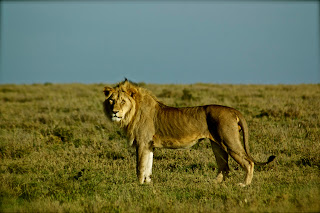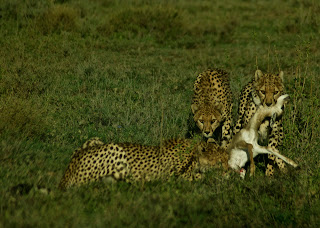Standing at 3,470m above sea level staring at the world’s largest lava lake makes you feel quite insignificant. It was cold at 4 a.m. and the precipice we were standing on kept us present, but the lava lake itself was mesmerizing We could feel the heat, generated in the depths of the Earth, the deep orange-red lava expressing itself vehemently, sometimes as explosive fountains and sometimes a moving kaliedescope of constantly shifting black plates. Occasionally the crater would fill with smoke and steam and all you could sense was the sound of the incredible deep rumble of the cauldron.

Nyiragongo, Democratic Republic of Congo
Standing at the top of Nyiragongo was one of the highlights of a sixteen-day safari that included two mountain summits and a combination of wildlife experiences. We began the safari by summiting Mt Meru, Africa’s 5th highest mountain (4568m asl). Climbing through the rich forest, through the heath and moorland vegetation zone, and finally onto the alpine desert gave us opportunities to enjoy a variety of beautiful birds including tacazze sunbirds, bar-tailed trogons, and silvery-cheeked hornbills.

A view of the ash cone in the right bottom corner and Little Meru.

An enchanted forest full of birds.

Incredible natural patterns.

The inner walls of the crater. Mt. Meru was once 5200m high, until the crater collapsed like Mt. St. Helens, in an explosion that was 10 times the magnitude of Mt. St. Helens.
Next up was Tarangire National Park. Tarangire is a classic African savannah complete with red soil, gigantic baobabs, and wildlife concentrations around water. We camped in the thick of it, close enough to a water-hole that we could hear elephants drinking, the water gurgling as it poured down their throats. We could smell the buffalo when they came down to drink, and when the lions roared we instinctively held our breath. Tarangire is also special because a tiny extension of the Somali Maasai Biome brings specialties like lesser kudu, fringe-eared oryx, and gerenuk.

The small fascinating stuff on a walk.

A lion track.
Our next destination was the Democratic Republic of Congo. To get there, we had to fly to Rwanda, stay a night in Kigali, and then drive three hours to the Gisenyi-Goma border crossing. The process hasn’t changed much since 2011 (read about it here), but by lunchtime we had arrived at Mikeno Lodge. Mikeno was our base for the next couple days, and the morning after arrival we drove up to Bukima Tented Camp to trek for gorillas.

A playful gorilla.

A sniffer dog used to catch poachers.
As you know, I place a lot of emphasis on experiences when I design safaris, often more than the level of luxury or comfort. For this reason, visiting Congo is exciting because that is what it is about. Mikeno Lodge and the new Bukima Tented Camp are very comfortable, but more importantly they are well situated for the experience. Gorillas are known to wander through the camp, and recently a group of chimpanzee moved into the forest around the lodge. Strolling around the lodge you can see beautiful colobus monkeys, blue monkeys, l’hoest’s monkeys if you’re lucky, and, if you get up early and head of with the trackers, chimp viewing.
The operational headquarters of the national park are also next to the lodge so you can get insight into conservation including a visit to the gorilla orphanage or the tracker-dog kennel.
The gorilla trekking rules in Congo are also slightly different to Rwanda and Uganda. A mask is essential to prevent transfer of disease from us to the gorillas, and the number of visitors allowed to a group is smaller. The authorities are also flexible and should you wish, you could actually trek to see two gorilla families in one day.
After completing our two gorilla treks, we returned to Mikeno Lodge to prepare for our Nyiragongo ascent.
The ICCN, who places the safety of tourists paramount, had only opened the volcano to visitors a few days before. We would have been the first visitors up the volcano had a small group of UN peacekeepers based in Goma not jumped at the chance a couple days before us. Like Mt. Meru, the climb takes you through rainforest and a heath and moorland zone. It is beautiful, but also steep. At least half of the climb is on the very uneven exposed surface of the lava flow of 2002.

Incredible plants.
The lava lake at 4 a.m. Nyiragongo.
The lava lake at 5 p.m. Nyiragongo.
We returned to Kigali exhilarated by the climb and tired from the lack of sleep. The next morning, we headed to Rubondo Island in Lake Victoria for a night. We should have included two nights on this beautiful island, but I wanted to spend a good three days in northern Serengeti rounding off the safari.
Elephants in Serengeti.
I had hoped to catch the tail end of the wildebeest migration as they headed south, but their early exodus had also drawn with it the multitude of camps and tourist vehicles leaving us virtually alone. As usual, the wildlife viewing was incredible: the cats including a mother cheetah with her four cubs who we watched hunt an oribi for dinner, lions and lion cubs, and to put the icing on the cake, a black rhino strolling across the plains as we spent our last morning before the return flight to Arusha.







































